John II Komnenos | Vikings | The Book of Kells | Origins and History
Articles and Definitions | Contents
- John II Komnenos | Who Was
- Vikings | Origins
- The Book of Kells | Origins
Ancient civilizations | Historical places, and their characters
John II Komnenos | Who Was
Definition and Origins
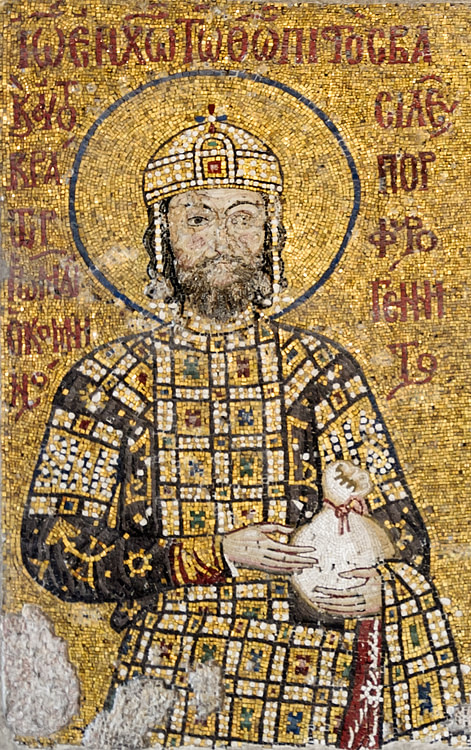
John II Komnenos “the Handsome” was emperor of the Byzantine Empire from 1118 CE to 1143 CE. John, almost constantly on campaign throughout his reign, would continue the military successes of his father Alexios I with significant victories in the Balkans, Armenia, and Asia Minor. The Byzantine Empire, thus, regained something of its former sparkle and the respect of its rivals across the Mediterranean.
SUCCESSION
John was born in 1087 CE, the son of emperor Alexios I Komnenos (r. 1081-1118 CE) and Irene Doukaina. When Alexios died of disease on 15 August 1118 CE, John, his chosen heir, became emperor as John II Komnenos. All very straightforward but things could have been very different. This is because it was actually Alexios’ eldest daughter, Anna Komnene, who was for a time Alexios' official heir following her marriage to Constantine Doukas, the son of Michael VII (r. 1071-1078 CE). When John was born, he, naturally, became the chosen heir. However, when Constantine Doukas died an early death, Anna then married the gifted general Nikephoros Bryennios the Younger and plotted with her grandmother, Anna Dalassena, to make her new husband the next emperor. The plan failed largely because Nikephoros remained loyal to the official heir John.
SECURING THE THRONE
John’s nickname of "the handsome" and his general character is explained as follows by the historian J. J. Norwich:
Even his admirers admitted that he was physically ill-favoured, with hair and complexion so dark that he was known as ‘the Moor’. He had, however, another nickname too: Kaloiannis, ‘John the Beautiful’. This was not intended ironically; it referred not to his body, but to his soul. Levity he hated: luxury he frowned upon. Today most of us would find him an insufferable companion; in twelfth-century Byzantium he was loved. First of all he was no hypocrite. He was genuine, his integrity complete. Second, there was a gentle, merciful side to his nature that in his day was rare indeed. He was generous, too: no Emperor ever dispensed charity with a more lavish hand. (266-7)
One of the first acts of John’s reign was, understandably, to banish his scheming sister Anna to a monastery, but at least this allowed her to write her celebrated Alexiad history of Byzantium in peace. John was indeed lenient with the other conspirators and their ring-leader Bryennios was even kept in service in the palace when, under most other emperors, he would have been blinded or executed. To ensure no future rivals conspired to oust him from his rightful position, John created an entourage of advisors and generals largely picked from outside the court. The supreme example of this policy was the selection of the emperor’s childhood friend, a Turkish former slave called John Axoukh, for the position of megas domestikos or supreme commander of the army. One of Axoukh’s many duties was to weed out any potential opposition to the emperor at court, especially as he was so often absent on his campaigns abroad.
John married Irene, the daughter of King Ladislaus I of Hungary (r. 1077-1095 CE), and the pair is realistically depicted in a mosaic panel in the south gallery of the Hagia Sophia, Istanbul. The mosaic dates to 1122 CE and shows the royal pair offering gifts to the Virgin and young Christ.
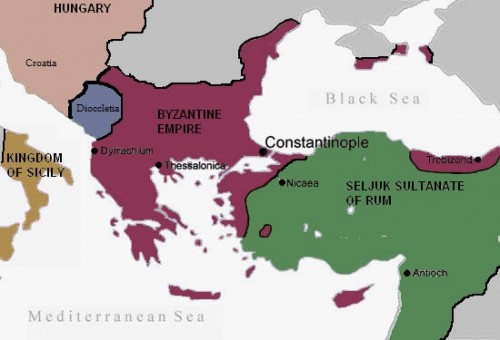
The Byzantine Empire c. 1090 CE
THE STATE OF THE EMPIRE
John inherited an empire in reasonable shape thanks to the stability of his father’s long reign (by Byzantine standards) and Alexios’ undoubted abilities as a general. The empire had resisted attacks from the Normans, and the 1108 CE Treaty of Devol promised no further hostilities between the two peoples. As a bonus, Alexios had gained a valuable ally in the Venetians in the process, although the price was reduced tax duties for the Italian merchants. The 1091 CE battle of Mount Lebounion had finally seen off the troublesome Pechenegs of the Eurasian steppe. Finally, the First Crusaders began to arrive in Constantinople from 1097 CE, and Alexios put them to good use by expanding the Byzantine military presence in Asia Minor and creating useful buffer fortresses against the ever-more ambitious Arabs. The Crusaders might have gone a little awry and captured such jewels as Antioch for themselves but at least they had been distracted from Constantinople.
MILITARY CAMPAIGNS
John’s military escapades continued where his father left off and the resurgent Pechenegs (Patzinaks) were once again defeated in the Balkans in 1122 CE. John had tricked the leaders by offering them gifts while his army attacked theirs. By no means a pushover, the battle was won thanks to the elite Varangian Guard, a mercenary corps of fearsome Vikings. Elsewhere, the Hungarians, now ruled by Stephen II, were pushed back into their own territory and the status quo restored, and, in 1129 CE, Serbia was obliged to accept Byzantine rule.
THE SUCCESSES KEPT COMING & IN 1137 CE THE RUBENIDS IN ARMENIA WERE CONQUERED & THEIR CAPITAL AT ANAZARBOS OCCUPIED.
In 1126 CE the trade privileges of the Venetians were renewed, ensuring their continued naval support in Byzantine campaigns, but this was only after the emperor had removed the privileges and the Venetians had convincingly argued their case by attacking the coast of Asia Minor and several islands in the Aegean. In 1130 CE John campaigned in Asia Minor against the Danishmendids, the Emirs of Cappadocia. Following five expeditions there, John returned to Constantinople and celebrated a triumph in 1133 CE.
The successes kept coming and in 1137 CE the Rubenids in Armenia were conquered and their capital at Anazarbos occupied. Then, in 1138 CE, Antioch was attacked, the prized cityhaving been in Crusader hands for the last 40 years. The current occupier, Raymond of Poitiers, was forced to swear loyalty and concede the city to Byzantine governance, although he actually went back on his promise to hand over the city. As the people of the city had revolted at the idea of returning to Byzantine authority, Raymond had actually had little choice in the matter.
In the west, as the Normans were expanding again in Italy and Sicily under the leader Roger II (r. 1130-54 CE), John made useful alliances in 1137 CE with the German emperor Lothar (r. 1125-37 CE) and then his successor Conrad III (r. 1138-52 CE). The alliance was strengthened in 1140 CE by the promise of marriage between John’s younger son Manuel and Conrad’s sister-in-law Sulzbach. Manuel had to wait five years and until he was emperor before the wedding finally took place. With the threat of Roger II diminished, John could look towards the east once more.
In 1138 CE John set off for a campaign against the Arabs in Syria, his army bolstered by a regiment of Knights Templar and a group led by Joscelin II of Courtenay, the Count of Edessa. The fortress city of Shaizar was selected as the first target and besieged. Before too much damage was done by John’s siege engines, though, the Emir of Shaizar wisely offered submission and a large tribute. Once again, the emperor returned home triumphant.
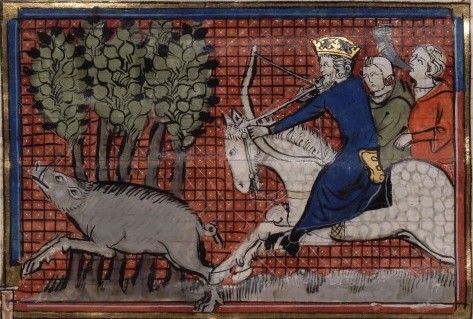
John II Komnenos Hunting
In September 1142 CE John returned to the old chestnut of Antioch and marched into Asia Minor once again. Raymond, still basking in his title "Prince of Antioch", managed to stall for a time, and this necessitated the Byzantine army withdrawing for the winter. The city then gained an unexpected reprieve when the emperor died suddenly the following spring.
DEATH & SUCCESSORS
John’s reign ended in a freak accident while the emperor was out hunting; falling on a poisoned arrow or perhaps contracting septicemia from the wound. He died on 8 April 1143 CE. John was succeeded by his younger son Manuel, now Manuel I Komnenos, who would enjoy an even longer reign, lasting until 1180 CE. Manuel had been the chosen heir after the unusual decision by John to pass over his elder son Isaac and following the unfortunate deaths of two other brothers from fever. Manuel turned out to be even more ambitious than his predecessors but ultimately came unstuck with a failed invasion of Italy and then a defeat at the hands of the Seljuks. The loss of Venetian support following the withdrawal of trade privileges and the continued threat of the Crusaders all added up to troubled times indeed for the Byzantine empire going into the 13th century CE when the unthinkable happened and Constantinople itself was sacked.
Vikings | Origins
Definition and Origins
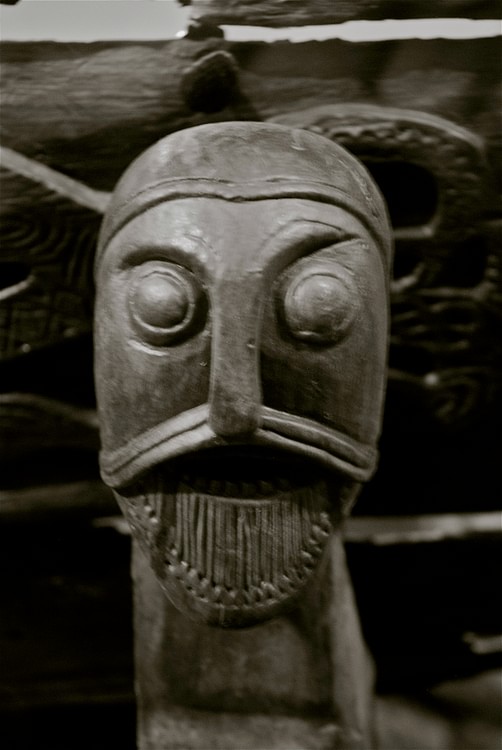
The Vikings were diverse Scandinavian seafarers from Norway, Sweden, and Denmark whose raids and subsequent settlements significantly impacted the cultures of Europe and were felt as far as the Mediterranean regions c. 790 - c. 1100 CE. The Vikings were all Scandinavian but not all Scandinavians were Vikings. The term Viking applied only to those who took to the sea for the purpose of acquiring wealth by raiding in other lands, and the word was primarily used by the English writers, not inclusively by other cultures. Most Scandinavians were not Vikings, and those who traded with other cultures were known as Northmen, Norsemen, or other terms designating their origin.
Beginning in 793 CE and continuing on for the next 300 years, the Vikings raided coastal and inland regions in Europe and conducted trade as far as the Byzantine Empire in the east, even serving as the elite Varangian Guard for the Byzantine Emperor. Their influence on the cultures they interacted with was substantial in virtually every aspect of life, most notably in the regions of Scotland, Britain, France, and Ireland. They founded Dublin, colonized Normandy (land of the Northmen) in France, established the area of the Danelaw in Britain, and settled in numerous communities throughout Scotland.
THE SCANDINAVIAN CULTURE WAS ACTUALLY HIGHLY DEVELOPED & THE VIKING RAIDS ON OTHER NATIONS WERE ONLY ONE ASPECT OF THE CIVILIZATION.
Their settlements in Iceland and Greenland spread Scandinavian culture further across the North Atlantic and placed them in an ideal position for further exploration and colonization. The Vikings were the first Europeans to visit North America and establish communities. The Newfoundland site of L’Anse Aux Meadows has been positively identified as an early Viking settlement while debate continues on other sites from Maine to Rhode Island – and even further south – as evidence of early Viking habitation or at least visitation in North America.
Although popularly imagined as warriors wearing horned helmets, this is inaccurate. Horned helmets would have been impractical in battle and were most likely only worn for ceremonial purposes. Further, although the Vikings were great warriors and their name in the present day is almost synonymous with warfare, slaughter, and destruction – an association encouraged by popular media representations – but the Scandinavian culture was actually highly developed and the Viking raids on other nations were only one aspect of the civilization.
NAME
The origin of the word 'Viking' is still debated by scholars. Professor Kenneth W. Harl represents the traditional view that Viking “comes from the Norse vik, meaning a cove or small fjord, a place where pirates could lurk and prey on merchant ships” (3). The philologist Henry Sweet claims the word derives from the Old Norse for “pirate” (Whitelock, 222). Professor Peter Sawyer argues that the word must come from the region of Viken, which flanked the Oslo Fjord, writing:
This district was of great value for it was there that the Danes could obtain the iron that was produced in Norway. If, as seems likely, the word Viking originally referred to the inhabitants of Viken, it could explain why the English, and only they, called Scandinavian pirates Vikings, for England was the natural objective for men from Viken who chose exile as raiders. (8)
Sawyer points out that other cultures all referred to these same people by different names – but none called them Vikings. The Irish records call them pagans or simply foreigners, the French called them Northmen, the Slavs called them the Rus (which gave Russia its name), and the Germans knew them as Ashmen in reference to their use of ash wood for their boats.
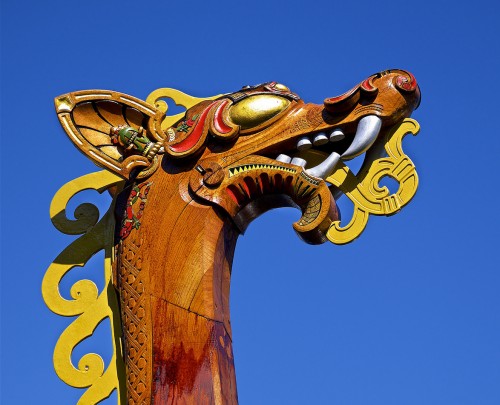
Viking Boat Figurehead
The Vikings used the word themselves to refer to the activity of armed raids on other lands for the purpose of plunder. The Old Norse phrase fara i viking (“to go on expedition”) had a distinctly different meaning than going on a sea voyage for the purposes of legitimate trade. When one decided to “go Viking” one was announcing one’s intention to join in raiding profitable targets in other lands.
CULTURE
The Viking culture was Scandinavian, with society divided into three classes, the Jarls (aristocracy), Karls (lower class), and Thralls (slaves). Upward mobility was possible for Karls but not Thralls. Slavery was widely practiced throughout Scandinavia and is considered one of the prime motivators for the Viking raids on other lands.
SLAVERY WAS WIDELY PRACTICED THROUGHOUT SCANDINAVIA & IS CONSIDERED ONE OF THE PRIME MOTIVATORS FOR THE VIKING RAIDS ON OTHER LANDS.
Women had greater freedoms in Scandinavian/Viking culture than in many others. Women could inherit property, choose where and how to live if unmarried, represent themselves in legal cases, and own their own businesses (such as breweries, taverns, shops, and farms). Women were the prophetesses of either the goddess Freya or the god Odin – there were no male religious leaders – and interpreted the gods’ messages for the people.
Marriages were arranged by the men of the clan, and a woman could not choose her own mate - but neither could a man. Women’s dress and jewelry were similar to men of their social class, and neither sex wore earrings which were thought to be affectations of lesser races. Women were responsible for raising children and keeping the house but both men and women prepared meals for the family.
Most Scandinavians were farmers, but there were also blacksmiths, armorers, brewers, merchants, weavers, luthiers (those who made stringed instruments), drum-makers, poets, musicians, craftsmen, carpenters, jewelers, and many other occupations. A significant source of income was trading amber, the fossilized resin of the pine tree, which they had in abundance. Amber frequently washed up on the shores around Scandinavia and was worked into jewelry or sold in semi-processed form, especially to the Roman and Byzantine empires.
Scandinavians enjoyed leisure time as much as any other culture and played sports, board games, and organized festivals. Sports included mock-combat, wrestling, mountain climbing, swimming, javelin-throwing, hunting, a spectacle known as horse-fighting whose details are unclear, and a field game known as Knattleik which was similar to hockey. Their board games included dice, games of strategy along the lines of chess, and chess itself.
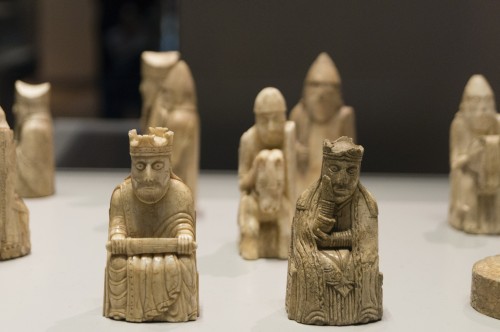
Lewis Chessmen
Contrary to the popular image of the Vikings as filthy and savage, they were actually quite refined and paid a great deal of attention to hygiene and appearance. Once trade was established with the east, Viking Jarls often wore silk and expensive jewelry. They braided their hair, were well groomed, and wore fine cloaks and intricately-crafted jewelry in the form of necklaces and arm- and wristbands.
Cleanliness was not only a sign of wealth and status but also had religious significance. Vikings made sure to always keep their finger and toenails short because of their belief in Ragnarok, the twilight of the gods and the end of the world, at which the ship Naglfar would appear floating on the waters unleashed by the great serpent Jormungand. Naglfar was built from the nails of the dead and so anyone who died with nails unpared provided ship-building material and hastened the inevitable end.
NORSE RELIGION
The end of the world was predestined but one could still struggle against it. The gods of the Norse provided the people with the breath of life, and it was then up to each individual to prove worthy of the gift. The Norse gods came to Scandinavia with the Germanic migrations sometime around the beginning of the Bronze Age (c. 2300 - c.1200 BCE). These were fierce gods who understood their time was limited and lived fully to make the most of it; their followers were encouraged to do the same.
The main sources for the Norse religious beliefs are the Poetic Edda, dated to oral traditions of the 9th and 10th centuries CE, and the Prose Edda (c. 1220 CE), a collection of tales based on older stories. In the Norse creation story, before the world was created there was only ice and a giant named Ymir who lived by the grace of the great cow Audhumla. Audhumla fed Ymir milk which ran continuously from her four udders while, at the same time, licking the ice for her own sustenance. Her licking freed the trapped god Buri who then produced a son, Borr.
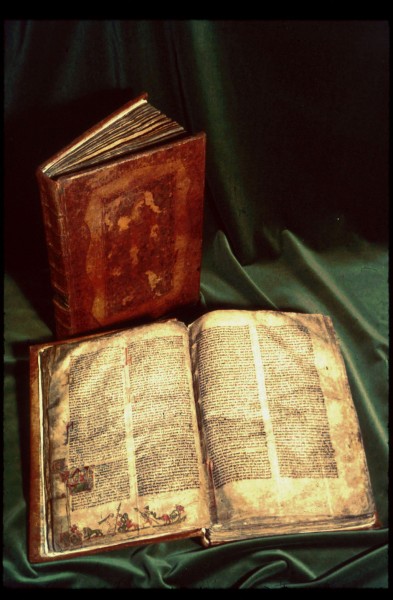
Codex Regius of the Poetic Edda
Borr married Bestla, daughter of Bolthorn the frost giant, and she gave birth to the gods Odin, Vili, and Vé. These gods united, killed Ymir, and used his body to create the world. The first human beings were Ask and Embla, who had no spirit or form until life was breathed into them by Odin, while other gods gave them reason and passion.
The world created by the gods was understood as an enormous tree, known as Yggdrasil, and included nine planes of existence. The most famous of these are Midgard (home for mortals), Asgard (home of the gods), and Alfheim (home of the elves) and another realm, Niflheim, located beneath Midgard where those who died poorly went. Heroic women, especially those who died in childbirth, went to the Hall of Frigg in Asgard where they spent eternity in the company Odin’s wife while men who died heroically in battle went to Odin’s hall of Valhalla.
The entire universe was established on the principles of order by Odin and the other gods after they had defeated the frost giants. The frost giants lived in their own realm, Jotunheim, but were a constant threat to both Asgard and Midgard. At some point in the future, a great day of destruction would come and chaos would be unleashed; this day was known as Ragnarök, the twilight of the gods.
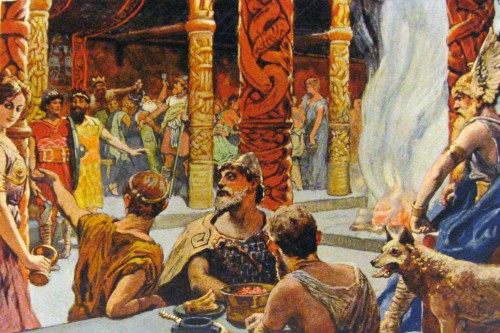
Valhalla
When Ragnarök came, the sun would be swallowed by the wolf Skoll and the moon by his brother Hati, plunging the world into darkness while, at the same time, the great wolf Fenrir would ravage through all the planes of Yggdrasil. The god Heimdall would sound his great horn, calling the gods to battle, and Odin would call up all the heroes from Valhalla’s halls to join with the gods in defending creation. The gods fight valiantly but, in the end, they fall in battle as the entire universe is consumed in flame and sinks into the primordial waters. Although this is the end of the world, it is not the end of existence; once this present world is destroyed, a new one is created and rises from the waters and the entire cycle repeats itself.
The Norse gods were honored through the actions of the people who believed in them. No evidence of a religious hierarchy has been found in Scandinavia prior to the coming of Christianity. Women who were touched by the gods were known as Volva and could hear the divine words and translate them for other mortals. Although there were some temples erected to the gods, most worship seems to have taken place in natural settings which had some connection to a certain deity. The stories of the gods, creation, and Ragnarök were transmitted orally and were only written down much later, in Iceland by the historian/poet Snorri Sturluson (1179-1241 CE).
SHIPBUILDING & THE VIKING RAIDS
The Norse mythology would influence the Viking culture and encourage their raids because the Viking life emulated that of the gods. Brave warriors went abroad to do battle against forces they saw as chaotic and dangerous. The Mediterranean and European religious belief in a single god and his savior son who needed priests, churches, nuns, books, and rules to be worshipped would have seemed absurd and threatening to the Vikings. There was nothing in the Christian teaching which resonated with Norse ideology. Once the Scandinavians had fully mastered shipbuilding and began to “go Viking,” they showed no mercy to the Christian communities they encountered, but early Scandinavian settlers in foreign lands frequently adopted the new faith.
Carvings from Scandinavia dated to c. 4000-2300 BCE show that the people already knew how to build boats at this time. These small ships were driven by paddles, had no keel, and would have made long-distance trips perilous; still, there is ample evidence that such journeys were made. Shipbuilding developed past this stage of small ferry boats only around c. 300-200 BCE and would not develop further until interactions with Roman traders and Celtic and Germanic merchants using Roman technology between c. 200-400 CE. The first ship able to navigate the sea easily is known as the Nydam ship, from Denmark, built c. 350-400 CE, though this ship had no sail.
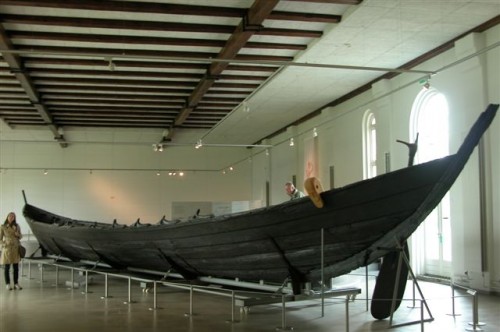
Nydam Ship
Long before the development of keel or sail, however, a number of Scandinavian traders established permanent communities in Europe and assimilated with the Christian culture, forgetting the stories of the Norse gods and their old religious practices. Professor Harl notes that by 625 CE,
The West Germanic kinsmen of the Scandinavians had converted to Christianity and had begun to forget their own stories. Between 650 and 700 CE, new Christian cultures emerged in England, in the Frankish world, and in Frisia, which led to a parting of the ways between the Scandinavian heartland and the new states in the former Roman Empire. (25)
This “parting of the ways” was largely due to differences in religious understanding and behavior. The Christian god was supposed to be omnipotent, omniscient, and omnipresent and this was a significant departure from the Norse gods who, like other pagan religions, each had their own area of expertise, their own lives and concerns, and whose actions explained the observable world in a way the Christian god did not. For the Vikings, the universe was full of gods and spirits and supernatural energies which infused a challenging world of adventure while, to the Christians, it was ruled by one deity who presided over a fallen world of sin; this difference in world views influenced how the Vikings dealt with the Christians they encountered on their raids.
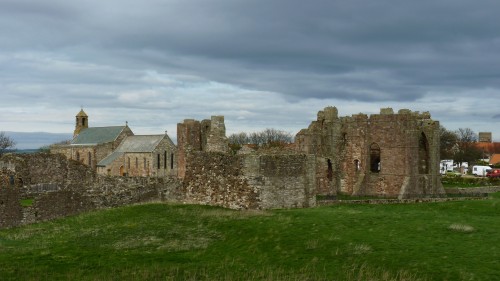
Lindisfarne
It would have been considered dishonorable for a Norse warrior to kill unarmed civilians and take their possessions, but this is precisely what the Vikings did between c. 793-1100 CE. They were able to do so because those they plundered were not Norse, were not bound by the same belief, and so the rules which maintained Viking society did not apply to them. When the Vikings first came to Britain and sacked the priory of Lindisfarne in 793 CE, they murdered every monk they found and carried off everything of value; this would have been considered a serious crime if the slain had been Norse, but as it was, the monks were simply obstacles to the acquisition of wealth and, further, it was abundantly clear that the Christian god had no power to defend his people if they could so easily be killed within the walls of their own place of worship.
EXPANSION & LEGACY
The Viking raids on Christian communities, like those of the Huns on the Roman Empirecenturies earlier, were interpreted by European Christians as God’s wrath on his people for their sins. In Britain, Alfred the Great (871-899 CE) would institute his reforms in education to better his people and appease his God. He also made baptism into the Christian faith a stipulation of treaties with the Vikings. When Alfred defeated the Viking army under Guthrum at the Battle of Eddington in 878 CE, Guthrum and 30 of his chieftains had to submit to baptism and conversion.
Charlemagne in France (800-814 CE) pursued a much more active course in attempting to forcefully Christianize the Scandinavians through military campaigns which destroyed sites sacred to Norse belief and established Christianity as an enemy faith of a hostile people. Charlemagne’s efforts have been cited by a number of historians as the primary motivation for the savagery of the Viking raids, but this claim does not take into account the raids on Britain and Ireland between 793-800 CE. There is little doubt, however, that Charlemagne’s evangelical holy wars did little to encourage Scandinavian acceptance of Christianity and only led to animosity and greater division.
In the early years of the Viking Age in Europe, the sea-raiders began as little more than pirates, but they would eventually arrive as great armies under charismatic and skilled military leaders, would conquer large territories and establish communities, and finally would assimilate with the local population. The Viking Age is known for legendary Norse leaders such as Halfdan Ragnarsson (also known as Halfdane, c. 865-877 CE), his brother Ivar the Boneless (c. 870 CE), Guthrum (c. 890 CE), Harold Bluetooth (c. 985 CE), his son Sven Forkbeard (986-1014 CE), Cnut the Great (1016-1035 CE) and Harald Hardrada (1046-1066). Other notable Norse explorers of the time were Eric the Red (died 1003 CE) and Leif Erikson (died c. 1020 CE) who explored and settled Greenland and North America.
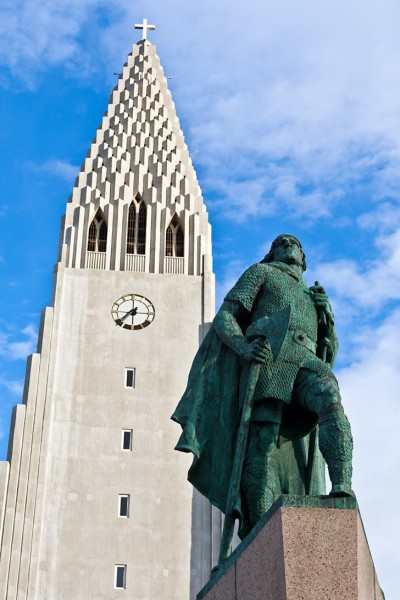
Leif Erikson
The Vikings were never defeated en masse in battle and no single engagement ended the Viking Age. The date agreed on by most scholars as the end of the Viking Age is 1066 CE when Harald Hardrada was killed at the Battle of Stamford Bridge, but Viking raids continued after this date. There were many factors which contributed to the end of the Viking Age but the Christianization of Scandinavia throughout the 10th and 11th centuries CE was certainly among the most significant. The Norse religion was the last of the great pagan belief systems to fall to Christianity, and once it did, there was no inspiration in the new faith for one to "go Viking" anymore.
The Vikings influenced the culture of every nation they came in contact with and in every conceivable way from architecture to language, infrastructure to poetry and place names, military reforms to food and clothing, and certainly in the areas of warfare and shipbuilding. Regularly depicted by medieval writers as marauding bands of murderous heathens, the Vikings would be re-imagined as noble savages by the early 20th century CE, and this is often how they are still portrayed in the present day. The Vikings were actually neither of these, however; they were a cultured and sophisticated warrior class who understood, based on their religious belief, that in raiding other lands for personal gain they had everything to win and nothing to lose.
The Book of Kells | Origins
Definition and Origins
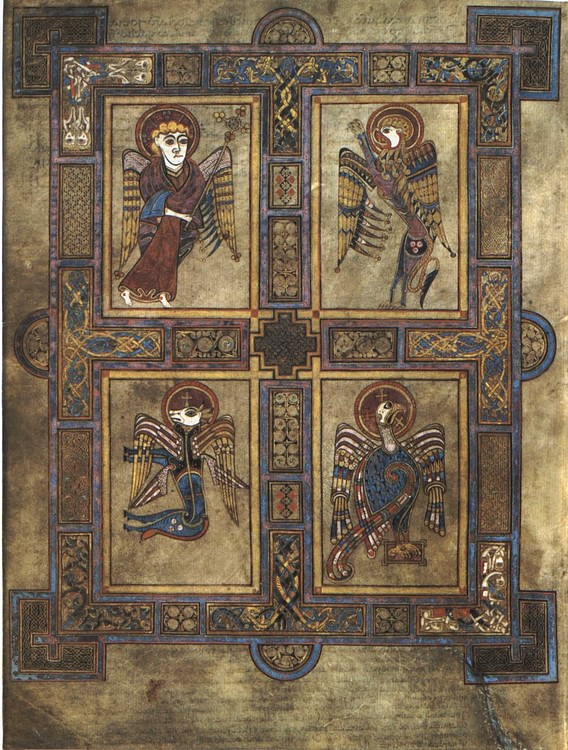
The Book of Kells (c. 800 CE) is an illuminated manuscript of the four gospels of the Christian New Testament, currently housed at Trinity College, Dublin, Ireland. The work is the most famous of the medieval illuminated manuscripts for the intricacy, detail, and majesty of the illustrations. It is thought the book was created as a showpiece for the altar, not for daily use, because more attention was obviously given to the artwork than the text.
The beauty of the lettering, portraits of the evangelists, and other images, often framed by intricate Celtic knotwork motifs, has been praised by writers through the centuries. Scholar Thomas Cahill notes that, “as late as the twelfth century, Geraldus Cambrensis was forced to conclude that the Book of Kells was “the work of an angel, not of a man” owing to its majestic illustrations and that, in the present day, the letters illustrating the Chi-Rho (the monogram of Christ) are regarded as “more [living] presences than letters” on the page for their beauty (165). Unlike other illuminated manuscripts, where text was written and illustration and illumination added afterwards, the creators of the Book of Kells focused on the impression the work would have visually and so the artwork was the focus of the piece.
ORIGIN & PURPOSE
The Book of Kells was produced by monks of St. Columba’s order of Iona, Scotland, but exactly where it was made is disputed. Theories regarding composition range from its creation on the island of Iona to Kells, Ireland, to Lindisfarne, Britain. It was most likely created, at least in part, at Iona and then brought to Kells to keep it safe from Viking raiders who first struck Iona in 795 CE, shortly after their raid on Lindisfarne Priory in Britain.
A Viking raid in 806 CE killed 68 monks at Iona and led to the survivors abandoning the abbey in favor of another or their order at Kells. It is likely that the Book of Kells traveled with them at this time and may have been completed in Ireland. The oft-repeated claim that it was made or first owned by St. Columba (521-597 CE) is untenable as the book was created no earlier than c. 800 CE; but there is no doubt it was produced by later members of his order.
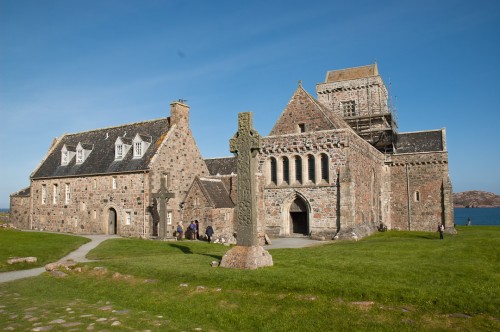
Iona Abbey
The work is commonly regarded as the greatest illuminated manuscript of any era owing to the beauty of the artwork and this, no doubt, had to do with the purpose it was made for. Scholars have concluded that the book was created for use during the celebration of the mass but most likely was not read from so much as shown to the congregation.
This theory is supported by the fact that the text is often carelessly written, contains a number of errors, and at points certainly seems an afterthought to the illustrations on the page. The priests who would have used the book most likely already had the biblical passages memorized and so would recite them while holding the book, having no need to read from the text.
Scholar Christopher de Hamel notes how, in the present day, “books are very visible in churches” but that in the Middle Ages this would not have been the case (186). De Hamel describes the rough outline of a medieval church service:
There were no pews (people usually stood or sat on the floor), and there would probably have been no books on view. The priest read the Mass in Latin from a manuscript placed on the altar and the choir chanted their part of the daily office from a volume visible only to them. Members of the congregation were not expected to join in the singing; some might have brought their Books of Hours to help ease themselves into a suitable frame of mind, but the services were conducted by the priests. (186)
The Book of Kells is thought to have been the manuscript on the altar which may have been first used in services on Iona and then certainly was at the abbey of Kells. The brightly-colored illustrations and illumination would have made it an exceptionally impressive piece to a congregation, adding a visual emphasis to the words the priest recited while being shown to the people; much in the way one today would read a picture book to a small child.
APPEARANCE & CONTENT
The book measures 13x10 inches (33x25 cm) and is made of vellum pages decorated in painted images which are accompanied by Latin text written in insular script in various colors of ink. It includes the complete gospels of Matthew, Mark, and Luke, and part of John as well as indexes and cross-references, summaries, and commentary. It was originally bound by a cover of gold and jewels which was lost when the manuscript was stolen from the abbey in 1007 CE. The ornate binding, front and back, was torn off by the thieves, which also resulted in the loss of some of the folios at either end, and this may have been when the latter part of the Gospel of John was lost.
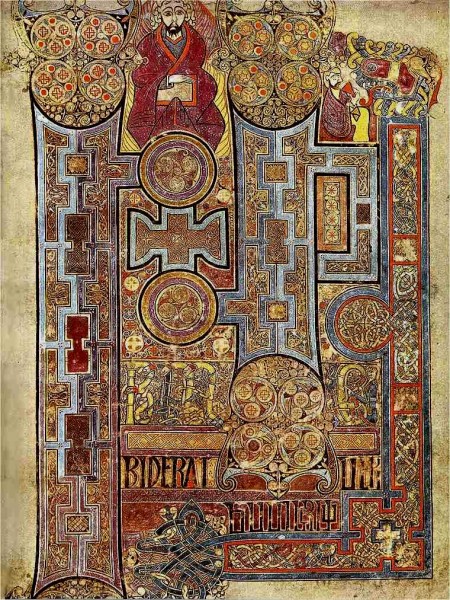
Book of Kells
It is also possible, however, that John may never have been completely copied. There is evidence that the Book of Kells is an unfinished manuscript. There are blank pages, for example, and some missing illustrations; although these may have been lost rather than never completed. The work was done by three separate anonymous scribes who are identified in the present day only as Hand A, Hand B, and Hand C. It was common for more than one scribe to work on a manuscript – even on a single page of a book – to proofread and correct another’s errors or to illuminate a text already copied.
CREATION
Monks produced illuminated manuscripts between the 5th and 13th centuries CE. After the 13th century CE, professional book-makers emerged to meet the growing demand for literary works. It was a natural outgrowth of the monastic life that monks should be the first copyists and creators of books. Each monastery was required to have a library as dictated by the rules of St. Benedict of the 6th century CE. Even though it is clear that some monks arrived at these places with their own books, it is equally evident that many others were borrowed from elsewhere and copied.
MONKS WERE INVOLVED IN EVERY ASPECT OF BOOK-MAKING FROM THE CULTIVATION OF THE ANIMALS WHOSE SKIN WOULD BE USED FOR THE PAGES TO THE FINISHED PRODUCT.
Monks who worked on books were known as scriptores and worked in rooms called scriptoriums. The scriptorium was a long room, lit only by the light from the windows, with wooden chairs and writing tables. A monk would sit hunched over these tables, which angled upwards to hold manuscript pages, day after day to complete a work. Candles or oil lamps were not allowed in the scriptorium to maintain the safety of the manuscripts as fire was an obvious and significant threat.
Monks were involved in every aspect of book-making from the cultivation of the animals whose skin would be used for the pages, to processing that skin into vellum, and on further to the finished product. Once the vellum was processed, a monk would begin by cutting down a sheet to size. This practice would define the shape of books from that time down to the present day; books are longer than they are wide because the monks needed a taller page to work on.
Once the vellum sheet was prepared, lines would be drawn across it to serve as rules for text and blank spaces left open on the sides and borders for illustrations. The text was written first in black ink between these ruled lines by one monk and then would be given to another to proofread. This second monk would then add titles in blue or red ink and then pass the page on to the illuminator who would add images, color, and the silver or gold illumination. Monks wrote with quill pens and boiled iron, tree bark, and nuts to make black ink; other ink colors were produced by grinding and boiling different natural chemicals and plants.
ILLUMINATION
The images in the Book of Kells (and other illuminated manuscripts) are called miniatures. Scholar Giulia Bologna explains:
The term miniature is derived from miniare, which means `to colour in red’; miniumis the latin name for cinnabar or mercuric sulphide. This red, used in wall-paintings at Pompeii, was put to common use colouring the initials of early codices, hence its name became the term used to indicate pictures in manuscript books. (31)
The artists who painted these works were known as miniaturists but later as illuminators. The illuminator would begin with a sheet of vellum on which text had usually already been written. The section of the page to be worked on would be rubbed by the monk with clay or isinglass or with "a mixture of ox-bile and egg-albumen or by rubbing the surface with cotton-wool dipped in a diluted glue-and-honey solution" (Bologna, 32). Once the surface was prepared, the monk readied his brushes - which were made of the hair of squirrel tails pressed into a handle - as well as his pens and paints and set to work. Errors in the image were erased by rubbing them away with chunks of bread.

Book of Kells
According to Bologna, "we learn of the techniques of illumination from two sources: from uncompleted manuscripts that allow us to observe the interrupted stages of the work and from the directions compiled by medieval authors" (32). The illuminator would begin by sketching an image and then tracing it onto the vellum page. The first layer of paint would be applied to the image and then left to dry; afterwards, other colors were applied. Gold or gold leaf was the first on the page to provide the illumination highlighted by the colors which followed. In this way, the great Book of Kells was produced.
HISTORY
Although it is clear how the manuscript was probably made, no consensus has ever been reached on where it was created. Christopher de Hamel writes:
The Book of Kells is a problem. No study of manuscripts can exclude it, a giant among giants. Its decoration is of extreme lavishness and the imaginative quality of its workmanship is quite exceptional. It was probably this book which Giraldus Cambrensis, in about 1185, called “the work of an angel, not of a man”. But in the general history of medieval book production the Book of Kells has an uncomfortable position because really very little is known about its origin or date. It may be Irish or Scottish or English. (21)
However that may be, most scholars agree on either a Scottish or Irish origin for the work and, since the monks of Iona were originally from Ireland, Irish influence is considered most prominent. The Book of Durrow (650-700 CE), certainly created in Ireland and predating the Book of Kells by more than century, shows many of the same techniques and stylistic choices. Thomas Cahill, writing on the development of literacy and book-making in Ireland, comments:
Nothing brought out Irish playfulness more than the copying of the books themselves…they found the shapes of letters magical. Why, they asked themselves, did a B look the way it did? Could it look some other way? Was there an essential B-ness? The result of such why-is-the-sky-blue questions was a new kind of book, the Irish codex; and one after another, Ireland began to produce the most spectacular magical books the world had ever seen. (165)
Cahill goes on to note how the Irish monks combined the letters of the Roman alphabetwith their own Ogham script and whatever fancies their imagination leaned them to produce the opening capital letters on the page, the headings, and the borders which framed the miniatures. Wherever the Book of Kells was started or finished, the Irish touch is unmistakable throughout the work.
As noted, it most likely came to Kells from Iona in 806 CE following the worst of the Viking raids on the island and is known to have been stolen in 1007 CE when its cover was lost; the text itself was found discarded. It is considered most likely the same book Giraldus Cambrensis so admired at Kildare in the 12th century CE but, if he is correct about this location, it was back at the abbey of Kells in the same century as land charters pertaining to the abbey were written on some of the pages.
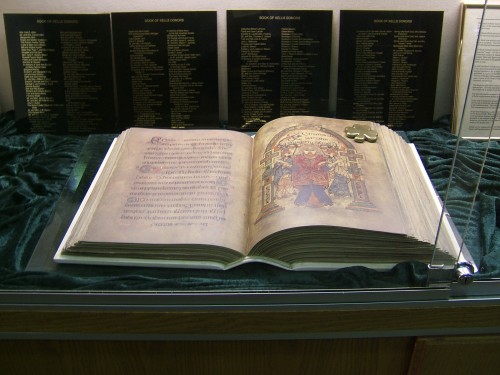
The Book of Kells
It remained at the abbey until the 17th century CE when Oliver Cromwell invaded Ireland (1649-1643 CE) and stationed a part of his force at Kells; at this time the manuscript was brought to Dublin for safe-keeping. It came into the hands of the bishop Henry Jones (1605-1682 CE), an alumnus of Trinity College, and Jones donated it to the college’s library in 1661 CE along with the Book of Durrow. The manuscript has been housed at the Trinity library ever since. In 1953 CE the book was rebound in four separate volumes to help preserve it. Two of these volumes are on permanent display at Trinity College; one showing a page of text and the other a page of illustration.
In 2011 CE the town of Kells mounted a petition to have at least one of these volumes returned. Arguing that they are the original owners of the manuscript, and citing the over 500,000 visitors who come to Trinity each year to see the work, the town claims that they deserve to share in some of the benefits of tourism that Trinity has enjoyed so long.
The request was denied, however, citing the delicate nature of the manuscript and the inability of Kells to care for it as well as Trinity College. Facsimiles have been made of the Book of Kells for scholars, art historians, and other fields of study but the manuscript itself is no longer loaned or allowed to be handled. The work remains at Trinity where it is displayed in an exhibit featuring additional information on the most famous of the illuminated manuscripts.
License
Article based on information obtained from these sources:with permission from the Website Ancient History Encyclopedia
Content is available under License Creative Commons: Attribution-NonCommercial-ShareAlike 3.0 Unported. CC-BY-NC-SA License